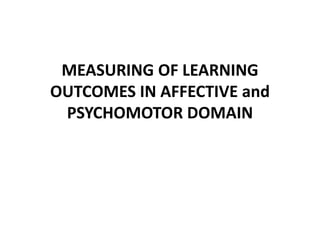
Measuring of learning outcomes in effective and psycho motor
- 1. MEASURING OF LEARNING OUTCOMES IN AFFECTIVE and PSYCHOMOTOR DOMAIN
- 2. Sub Topics 1. Observational Techniques 2. Rating Scales 3. Anecdotal Record 4. Checklists 5. Peer Appraisal 6. Self Reports
- 3. Observation Method • “A systematic description of events, behaviors, and artifacts in the social setting chosen for study“(Kawulich 2005) • It’s a description of perceptions from the five (5) senses of sight, hearing, touch ,taste and smell to provide a "written photograph" of the situation under study. • Unscientific observation is unsystematic; this is the everyday method.
- 4. Its types 1. Participant observation 2. Non-Participant observation 3. Structured observation 4. Non- Structured 5. Naturalistic Observation
- 5. Main Features • Non-experimental design. • Absence of independent variable does not allow any cause and effect relationship. • Key feature – Standardized plan and systematic approach to objectively observe and record behavior.
- 6. Observational Techniques • Personal observation • Mechanical observation • Trace Analysis • Content analysis
- 7. Rating Scales • A rating scale is a psychiatric measuring instrument used, to judge and rate a person at a specified scale level with respect to identified characteristics. • Rating scales can help to evaluate the quality of the behavior of one student or many students. It also measure the degree to which a student exhibits a specified behavior.
- 8. Usefulness • These scales are useful when they are combined with other types of assessment, such as with data obtained from: 1. Interval Recording 2. Event Recording;
- 9. An Example of Descriptors in a Rating Scale Elliot, Busse, and Greshman (1993) suggested that the following issues be considered when using rating scales: 1. Ratings are summaries of observations of the relative frequency of specific behaviors. 2. Ratings of social behavior are judgments affected by one’s environment and rater’s standards for behavior. 3. The social validity of the behaviors one asses and eventually treats should be understood. 4. Multiple assessors of the same child’s behavior may agree only moderately. 5. Many characteristics of a student may influence social behavior; however the student’s sex is a particularly salient variable.
- 10. COMPONENETS OF RATING SCALE The rating scale has two components: • Stimulus variable The stimulus variable consists of trait names or qualities to be rated. • Response options The response options consists of numerical or descriptive categories.
- 11. According to Guilford, rating scales are divided into six categories: • Numerical rating scales • Graphic scales • Percentage rating • Standard scales • Scales of cumulated points • Forced choice scales
- 12. Numerical Rating Scale (9 types) 1. Extremely disagree 2. Strongly disagree 3. Moderately disagree 4. Mildly disagree 5. Indifferent 6. Mildly agree 7. Moderately agree 8. Strongly agree 9. Extremely agree
- 13. Example • More and more countries should join UNO. Strongly agree Agree Indifferent Disagree Strongly agree • Political leaders should obey the directions of the UNO. Strongly agree Agree Indifferent Disagree Strongly agree
- 14. GRAPHIC RATING SCALE • The graphic rating scale is the most popular and widely used rating scale. In one way the graphic scale may be considered as an improvement over the numerical scale because it tends to overcome some of the difficulties faced with the numerical scale
- 15. Example • Mrs. ABC delivers lectures in the class room: Extremely rapidly Tolerably speed With slow Sluggishly slowly Extremely rapidly • In school gossip, she: Talks necessary Talks easily listen Talks when talking prefers to abstains from great deal • The first example illustrate the scale points through a continuous line • whereas the second example illustrates the scale points through broken lines. In both the examples the scale points have been demonstrated in a horizontal manner.
- 16. CONT. • Limitation of graphic scale is..they provide space only for the shorter descriptive cues. • Advantages of graphic scales:- They have no numerical anchors. As such the rater experience no confusion arising out of the need for numerical discrimination. They are simple, easily administered and quickly completed by the raters. • Disadvantage:- Graphic scales take time and labour in scoring.
- 17. PERCENTAGE SCALE • Percentage rating is done whenever the investigator wants a quick rating with maximum uniformity from rater to rater. The technique requires the rater to place the rates among different specified percentage groups or into different percentiles or quartiles such as given below: • Highest 5 per cent • Second highest 5 per cent • Highest 25 percent excluding the top 25 per cent • Top half but not the top 25 per cent
- 18. STANDARD SCALE • Standard scales are not very popular rating scales for psychological measurement. In it the rater is presented with some standards with pre-established scale values. These standards usually consist of objects of the same kind e.g: they any be the names of persons.
- 19. EXAMPLE • Scale values Name • Very high Lt. A • High Col. B • Average Brig. C • Low Lt.D • Very low Lt.E
- 20. DO YOU SELF • IF U HAVE INTREST THEN SEARCH IT
- 21. ADVATAGES OF RATING SCALE • Evaluate performance that not readily measure by testing. • Give more insight on how well/ often the child performed each task. • Structured and standardized. • Easy to compare. • Encourages equality in treatment. • Impose standard measure of performance • Easy to use and understand. • Forces teacher to make a decision. • Economical in cost and time. • Reduce rater bias and subjectivity by using standardized presentation of questions.
- 22. BIBLIOGRAPHY • Singh A.K; Tests, Measurement and research methods in behavioural sciences; fifth edition- reprint; bharatibhawan publishers; New Delhi 2009; pg. no. 262-287.
